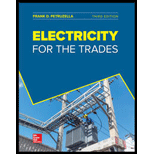
ELECTRICITY FOR TRADES (LOOSELEAF)
3rd Edition
ISBN: 9781260437454
Author: Petruzella
Publisher: MCG
expand_more
expand_more
format_list_bulleted
Textbook Question
Chapter 5.2, Problem 1RQ
What best describes a simple circuit?
Expert Solution & Answer
Want to see the full answer?
Check out a sample textbook solution
Students have asked these similar questions
A single tone is modulated using FM transmitter. The SNR, at the input of the demodulator
20 dB. If the maximum frequency of the modulating signal is 4 kHz, and the maximum
equency deviation is 12 kHz, find the SNR, and the bandwidth (using Carson rule) at the
ollowing conditions:
. For the given values of fm and Af.
!. If the amplitude of the modulating signal is increased by 80%.
3. If the amplitude of the modulating signal is decreased by 50%, and frequency of modulating
signal is increased by 50%.
The circuit shown below on the left has the following parameters:
V₁ = 5 V.
R₁ = 40,
R₂ = 40,
α = 0.1.
This circuit can be replaced by an equivalent circuit shown below on the right such that the voltage and current received by an arbitrary load resistor RL, are identical
when connected to either circuits.
Determine the value of the resistor R (in ) in the equivalent circuit.
R₁
Rx
R2
R₁
Vx
R₁
Vi
απ.
b
1. Consider the following a unity feedback control system.
R(s) +
E(s)
500(s+2)(s+5)(s+6)
s(s+8)(s+10)(s+12)
-Y(s)
Find the followings:
a) Type of the system
b) Static position error constant Kp, Static velocity error constant Ry and Static
acceleration error constant Ka
c) Find the steady-state error of the system for (i) step input 1(t), (ii) ramp input t 1(t),
(iii) parabolic input t² 1(t).
2. Repeat the above problem for the following system.
R(s) + E(s)
500(s + 2)(s + 5)
(s+8)(s+ 10)(s+12)
Y(s)
3. Repeat the above problem for the following system.
R(s) +
E(s) 500(s+2)(s+4)(s+5)(s+6)(s+7)
s²(s+8)(s+10)(s+12)
Y(s)
Chapter 5 Solutions
ELECTRICITY FOR TRADES (LOOSELEAF)
Ch. 5.1 - Prob. 1RQCh. 5.1 - Polarity markings are shown on symbols...Ch. 5.1 - Compare the type of voltage produced by a solar...Ch. 5.1 - Explain how circuit breakers and fuses protect a...Ch. 5.1 - What are the two basic functions of a switch?Ch. 5.1 - Compare the operation of a normally open and...Ch. 5.1 - What type of circuit component is a light bulb...Ch. 5.1 - In general, what is the function of resistors...Ch. 5.1 - Two wires are shown on an electrical diagram...Ch. 5.1 - Give one advantage and one limitation of the...
Ch. 5.1 - Explain why schematic diagrams are easier to read.Ch. 5.1 - What is a wiring diagram intended to show?Ch. 5.1 - Prob. 13RQCh. 5.1 - The one-line diagram is often used with a power...Ch. 5.2 - What best describes a simple circuit?Ch. 5.2 - A lamp is to turn ON when either one or the other...Ch. 5.2 - What connection of two or more switches can be...Ch. 5.2 - Three 120-V, 40-W incandescent lamps are connected...Ch. 5.2 - Two 12-V, 10-W lamps are connected in parallel to...Ch. 5.2 - A control system calls for a light to come on when...Ch. 5.2 - One bulb in a 20-string series-connected holiday...Ch. 5.2 - Prob. 8RQCh. 5.2 - Prob. 9RQCh. 5.2 - Prob. 10RQ
Knowledge Booster
Learn more about
Need a deep-dive on the concept behind this application? Look no further. Learn more about this topic, electrical-engineering and related others by exploring similar questions and additional content below.Similar questions
- 4. Consider a unity (negative) feedback control system whose open-loop transfer function is given by the following. 2 G(s) = s³ (s + 2) Find the steady-state error of the system for each of the following inputs. = a) u(t) (t²+8t+5) 1(t) b) u(t) = 3t³ 1(t) c) u(t) (t+5t² - 1) 1(t) =arrow_forward1 2. For the following closed-loop system, G(s) = and H(s) = ½ (s+4)(s+6) a. Please draw the root locus by hand and mark the root locus with arrows. Calculate the origin and angle for asymptotes. b. Use Matlab to draw the root locus to verify your sketch. Input R(s) Output C(s) KG(s) H(s)arrow_forward5. Consider following feedback system. R(s) + 100 S+4 +1 Find the steady-state error for (i) step input and (ii) ramp input.arrow_forward
- 6. Find (i) settling time (Ts), (ii) rise time (Tr), (iii) peak time (Tp), and (iv) percent overshoot (% OS) for each of the following systems whose transfer functions are given by: a) H(s) = 5 s²+12s+20 5 b) H(s) = s²+6s+25 c) H(s) = (s+2) (s²+12s+20) (s²+4s+13) Use dominant pole approximation if needed.arrow_forward7. Answer the following questions. Take help from ChatGPT to answer these questions (if you need). But write the answers briefly using your own words with no more than two sentences and make sure you check whether ChatGPT is giving you the appropriate answers in the context of class. a) Why do we need transient performance metrics? Name a few of such metrics. b) Define (i) settling time, (ii) rise time, (iii) peak time and (iv) percent overshoot. c) What is damping ratio? How does overshoot change with the change of damping ratio? When do we have zero overshoot? d) What is the criterion for selecting dominant pole in higher order systems? When dominant pole approximation is not valid? How will you calculate the transient performance metrics for the case when dominant pole approximation does not hold?arrow_forwardThe transformer rating is 1200:2400 V @ 120 kVA. What is the apparent power provided by the source? What does this mean for the operation of the transformer? Draw the power triangle at the source and calculate the power factor. The magnitude of the voltage source is given in VRMS.arrow_forward
- Don't use ai to answer i will report your answerarrow_forwarda) Find the Real and Imaginary Voltage across the inductor to 3 decimal points. b) Find the current and phase angle (phasor) magnitude from the Vs source to 3 decimal points. c) Find the magnitude and phase angle of the complex power(phasor) delivered by the Vs source to 3 decimal points.arrow_forwardConsider the circuit diagram below. If four identical capacitors, each with a capacitance of 0.07 F, are used to smooth the output, what will the ripple voltage VR be? The diode forward bias voltage, VF, is found to be 0.5 V. Note that the amplitude of v(t) is given in VRMS.arrow_forward
- a) Find the complex power absorbed by the -j3 ohm capacitor to 3 decimal points.b) Find the complex power absorbed by the 4 ohm resistor to 3 decimal pointsc) Find the complex power absorbed by the j5 ohm inductor to 3 decimal points.arrow_forwardI am looking for schematic ideas or recommendations for designing the required step-down system. Since the input is a 600V DC supply, a DC-DC converter may be necessary, as transformers are typically used for AC voltage. Key considerations would include: Voltage regulation: Ensuring a stable and consistent 120V DC output.Component selection: Choosing appropriate DC-DC converter modules, capacitors for filtering, and protective components such as fuses or circuit breakers.Lighting system: Recommendations on energy-efficient lighting options like LEDs, which work well with DC power and offer durability for railway applications.Thermal management: Addressing heat dissipation within the converter and lighting circuit.Safety and standards: Complying with safety regulations for electrical systems in railways. I would greatly appreciate detailed insights into the design process, including key circuit components and configurations, as well as any schematic diagrams or references.arrow_forward1 2. For the following closed-loop system, G(s) = and H(s) = ½ (s+4)(s+6) a. Please draw the root locus by hand and mark the root locus with arrows. Calculate the origin and angle for asymptotes. b. Use Matlab to draw the root locus to verify your sketch. Input R(s) Output C(s) KG(s) H(s)arrow_forward
arrow_back_ios
SEE MORE QUESTIONS
arrow_forward_ios
Recommended textbooks for you
 EBK ELECTRICAL WIRING RESIDENTIALElectrical EngineeringISBN:9781337516549Author:SimmonsPublisher:CENGAGE LEARNING - CONSIGNMENT
EBK ELECTRICAL WIRING RESIDENTIALElectrical EngineeringISBN:9781337516549Author:SimmonsPublisher:CENGAGE LEARNING - CONSIGNMENT Electricity for Refrigeration, Heating, and Air C...Mechanical EngineeringISBN:9781337399128Author:Russell E. SmithPublisher:Cengage Learning
Electricity for Refrigeration, Heating, and Air C...Mechanical EngineeringISBN:9781337399128Author:Russell E. SmithPublisher:Cengage Learning

EBK ELECTRICAL WIRING RESIDENTIAL
Electrical Engineering
ISBN:9781337516549
Author:Simmons
Publisher:CENGAGE LEARNING - CONSIGNMENT

Electricity for Refrigeration, Heating, and Air C...
Mechanical Engineering
ISBN:9781337399128
Author:Russell E. Smith
Publisher:Cengage Learning
02 - Sinusoidal AC Voltage Sources in Circuits, Part 1; Author: Math and Science;https://www.youtube.com/watch?v=8zMiIHVMfaw;License: Standard Youtube License